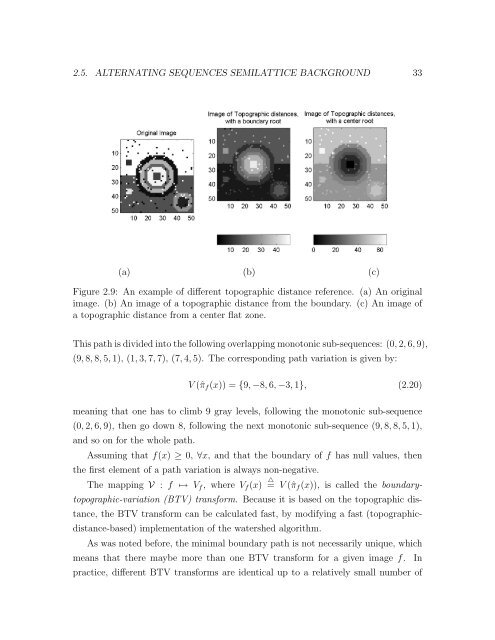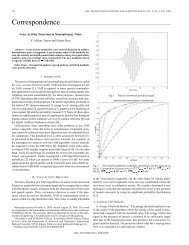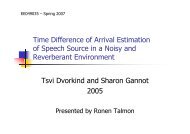Thesis (PDF) - Signal & Image Processing Lab
Thesis (PDF) - Signal & Image Processing Lab
Thesis (PDF) - Signal & Image Processing Lab
Create successful ePaper yourself
Turn your PDF publications into a flip-book with our unique Google optimized e-Paper software.
2.5. ALTERNATING SEQUENCES SEMILATTICE BACKGROUND 33<br />
(a) (b) (c)<br />
Figure 2.9: An example of different topographic distance reference. (a) An original<br />
image. (b) An image of a topographic distance from the boundary. (c) An image of<br />
a topographic distance from a center flat zone.<br />
This path is divided into the following overlapping monotonic sub-sequences: (0, 2, 6, 9),<br />
(9, 8, 8, 5, 1), (1, 3, 7, 7), (7, 4, 5). The corresponding path variation is given by:<br />
V (ˆπf(x)) = {9, −8, 6, −3, 1}, (2.20)<br />
meaning that one has to climb 9 gray levels, following the monotonic sub-sequence<br />
(0, 2, 6, 9), then go down 8, following the next monotonic sub-sequence (9, 8, 8, 5, 1),<br />
and so on for the whole path.<br />
Assuming that f(x) ≥ 0, ∀x, and that the boundary of f has null values, then<br />
the first element of a path variation is always non-negative.<br />
The mapping V : f ↦→ Vf, where Vf(x) △ = V (ˆπf(x)), is called the boundary-<br />
topographic-variation (BTV) transform. Because it is based on the topographic dis-<br />
tance, the BTV transform can be calculated fast, by modifying a fast (topographic-<br />
distance-based) implementation of the watershed algorithm.<br />
As was noted before, the minimal boundary path is not necessarily unique, which<br />
means that there maybe more than one BTV transform for a given image f. In<br />
practice, different BTV transforms are identical up to a relatively small number of
















